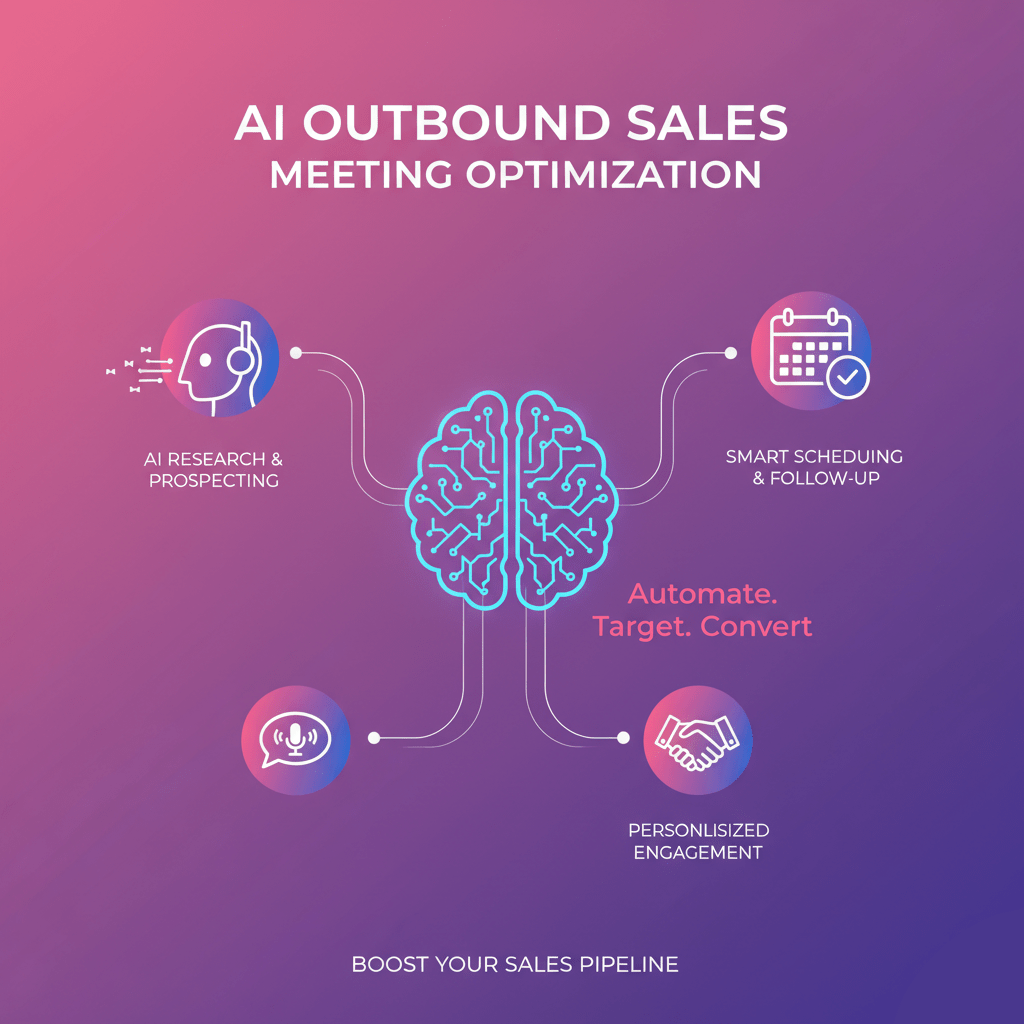“An AI for booking outbound sales meetings automates cold calling, objection handling, and appointment setting, enabling sales teams to scale their pipeline with perfect, tireless execution.”
The outbound sales game is challenging. Let’s not sugarcoat it.
Your Sales Development Reps (SDRs) are burning out. They spend their entire day staring at a dialer, facing brutal rejection, navigating complex phone trees, and getting hung up on… all for the chance to book one or two qualified meetings.
The math is grim. A marvelous SDR makes 80-100 dials a day. They might connect with 5 to 10 of those people. They might have 2-3 actual conversations. And from that, they might book one meeting. That’s a considerable amount of manual, repetitive, soul-crushing effort for a tiny return.
As a sales leader, you’re stuck. You need to fill your AEs’ calendars to hit your number. But you can’t just hire your way out of the problem. Hiring, training, and retaining SDRs is expensive and time-consuming. And even if you double your team, you’re just doubling the burnout.
Email outreach? That’s just as bad. Inboxes are beyond saturated. Your carefully crafted sequences are getting ignored, marked as spam, or deleted by prospects who get 50 similar emails a day.
For years, we’ve tried to fix this with “productivity” tools. Sales engagement platforms helped us send more emails and manage our call lists. However, the SDR still had to do the most challenging part: the actual, real-time, human conversation.
Until now.
The game has fundamentally changed. We’re not talking about AI that suggests an email template. We’re talking about AI that picks up the phone, dials the number, navigates the gatekeeper, has a two-way conversation, handles objections, and books a qualified meeting directly in your calendar.
This isn’t science fiction. This is the new reality of AI for booking outbound sales meetings. This article is the definitive playbook for making it work. We’re moving past theory and giving you the exact, actionable steps to build a predictable, scalable, and highly effective outbound machine.
And then, we’ll show you the engine that runs this entire playbook: SalesCloser.ai.

Chapter 1: The ‘Why’ – The Unspoken Failure of Traditional Outbound
Before we build the new model, we must be brutally honest about why the old one is broken. The traditional, human-only SDR model is failing, and it’s not the reps’ fault. It’s the model itself.
The Math is Stacked Against You
Let’s break down a typical day for a top-performing SDR:
- Dials per day: 100
- Connect Rate (Someone actually picks up): 8% (This is generous)
- Total Connects: 8 people
- Conversation Rate (They don’t hang up immediately): 50%
- Total Conversations: 4 people
- Meeting Booked Rate (From a conversation): 25%
- Total Meetings Booked: 1 per day
Your rep spends 8 hours of grinding, rejection, and manual data entry to get one meeting. This low level of sales development productivity is the bottleneck for your entire revenue engine. You can’t build a predictable forecast on this.
The Human Element is a Double-Edged Sword
We love our representatives for their humanity—their empathy, sense of humor, and ability to connect with us. However, that same humanity can be a liability in top-of-funnel prospecting.
- Call Reluctance: It’s real. After 30 consecutive voicemails and five harsh hang-ups, even the best representative hesitates to make that next call—their enthusiasm plummets.
- Inconsistency: Humans have “off” days. An AI agent does not. An AI agent delivers your best pitch, with perfect energy, every single time.
- Burnout: The SDR role has one of the highest turnover rates in any industry. We’re hiring smart, ambitious people and forcing them to do robotic, repetitive work. It’s no wonder they leave.
- Ramp Time: A new SDR takes, on average, 3-6 months to become fully productive. You’re bleeding money on salaries, training, and tools just to reach that one meeting a day baseline.
The Scaling Nightmare
You need 100 meetings this month. Your current team of 5 SDRs is booking 100 meetings combined (1 meeting/day x 5 reps x 20 workdays). To reach 200 meetings, you’d need to hire five more representatives, wait 3-6 months for them to ramp up, and hope they don’t burn out.
This is not a scalable system. This is a linear, expensive, and fragile process. You’re trying to scale your outbound efforts, but you’re limited by human bandwidth.
This is the core problem. The “cold call” is the highest-leverage activity in sales, but it is also the hardest one to perform at scale. We’ve optimized everything around the call, but we’ve never been able to optimize the call itself.
Chapter 2: The Big Shift: From Task Automation to Conversation Automation
Let’s get one thing straight. This is not about a cold outreach automation tool that just sends more spam. A sales engagement platform, such as Salesloft or Outreach, serves as a task manager. It helps a human rep organize their work: “You have 20 calls to make, 15 emails to send, and 5 LinkedIn tasks.”
The rep still has to do the work.
The modern shift is about automating the conversation itself.
Imagine an agent who serves as the SDR for the top of the funnel. This agent is an AI, not a person.
- It connects to your list of 20,000 prospects.
- It dials hundreds of numbers simultaneously.
- It instantly recognizes a voicemail and leaves a perfect, pre-recorded (or AI-generated) message.
- It instantly recognizes a human connection and switches to a live, conversational AI.
- It follows your script perfectly.
- It understands the prospect’s responses, questions, and objections in real-time.
- It answers those objections based on your playbook.
- Its only goal is to navigate the conversation and book a meeting with a qualified prospect.
This is the ultimate alternative to cold calling, powered by AI. It takes 80% of the SDR job, which is repetitive and demoralizing (dialing, voicemails, and initial objections), and automates it with perfect precision.
This frees up your human SDRs to do what humans do best: build relationships, conduct in-depth discovery, and handle the complex, nuanced conversations that arise from the meetings the AI has booked.
Your team’s productivity doesn’t just go up 10%. It goes up 1000%. You’re not just booking one more meeting a day. You’re booking 10, 20, or 50. You are transforming your outbound prospecting from a manual art form into a predictable science.
Chapter 3: The Playbook Part 1: Building the ‘AI-Ready’ List
This is the most crucial step. You cannot automate garbage.
An AI agent will only be as good as the data you feed it. If you give it a bad list, it will just burn through that bad list at lightning speed. A human SDR might realize after 20 calls that the list is bad. An AI will make 1,000 calls before you even check the dashboard.
“Garbage in, garbage out” is the iron law. Here’s how you build a list that’s primed for AI.
Step 1: Get Hyper-Specific on Your ICP
Your Ideal Customer Profile (ICP) can’t just be “tech companies in North America with 500+ employees.” That’s lazy, and it will get you lazy results. You need to go deeper.
- Firmographics: Yes, you need the basics: industry, company size, revenue, and location.
- Technographics: What technology do they currently use? (e.g., Are they using a competitor? Are they using a complementary tool?)
- Triggers (The ‘Why Now’): This is the secret sauce. What just happened that makes them need you?
- Hiring: Are they actively posting jobs for “Account Executives” or “Sales Development Reps”? (This is a perfect trigger for a tool that helps with… sales development!)
- Funding: Did they just raise a Series B? (They have cash and pressure to grow.)
- New Leadership: Did they just hire a new VP of Sales? (New leaders love to shake things up and bring in new tools.)
- Bad News: Did their competitor just launch a new product? Are they getting bad reviews?
Your modern prospecting strategy relies on these triggers.
Step 2: Map Your Personas
Inside that perfect ICP account, who are you calling?
- The Economic Buyer (e.g., VP of Sales): They care about ROI, revenue, team productivity, and hitting the forecast.
- The Champion (e.g., SDR Manager): They care about ramp time, rep burnout, call coaching, and meeting quotas.
- The User (e.g., SDR): They care about ease of use, making their job easier, and hitting their commission.
You must build different lists for each persona. Why? Because, as we’ll see in the next chapter, they each require a completely different script.
Step 3: Data Acquisition and Hygiene
Now you find these people. Utilize tools such as ZoomInfo, Apollo.io, LinkedIn Sales Navigator, or Clearbit.
However, the most critical piece of data, the one on which this entire playbook hinges, is a direct-dial phone number or mobile number.
Do not build a list of general office lines. Your AI will spend all day talking to switchboards and receptionists. That’s a waste of its power. You need to invest in data that gets you as close to the prospect as possible.
Once you have the list, clean it.
- Validate numbers: Use a service to ping the numbers and see if they’re active.
- Remove duplicates: Don’t call the same person 5 times.
- Normalize data: Make sure “VP, Sales” and “Vice President of Sales” are all tagged the same way.
Step 4: Segment, Segment, Segment
Do not, under any circumstances, give your AI a single list of 10,000 prospects. You must break it down.
- List A: VPs of Sales at Series B SaaS companies (500-1000 employees) who are currently hiring SDRs.
- List B: SDR Managers at logistics companies (1000+ employees) who use Salesforce and Outreach.
- List C: VPs of Marketing at e-commerce companies who just received funding.
Each of these segments is a different play. Each gets its own script, its own value proposition, and its own logic for handling objections. This segmentation is what enables your AI to sound incredibly personal and relevant, rather than like a generic robot.
Chapter 4: The Playbook Part 2: Crafting the ‘Conversational Map’
Stop thinking of this as a “script.” A script is a one-way monologue. This is a “conversational map.” It’s a dynamic, branching logic tree that guides the AI on how to behave in an honest, two-way conversation.
This is where you embed your best sales training directly into the machine.
The Opener (The First 7 Seconds)
This is the most critical part of the call. You have seconds to avoid the “I’m not interested” hang-up.
- The BAD Opener: “Hi, my name is Alex from SalesCorp, how are you today? I’m calling about our amazing platform that can…”
- Why it Fails: It’s a sales pitch. It’s disingenuous (“How are you today?”). The prospect’s defenses go straight up.
- The GOOD Opener (Pattern Interrupt): “Hi [Prospect Name], this is [AI Name] from [Your Company].
- Pause.
- “This is a cold call. I know you weren’t expecting it. Do you want to hang up, or can I have 30 seconds to tell you why I called you specifically?”
- Why it Works:
- It’s honest: “This is a cold call.” This disarms the prospect.
- It gives them an out: “Do you want to hang up…” This gives them a feeling of control.
- It creates a micro-commitment: When they say “fine, you have 30 seconds,” they have agreed to listen.
- It’s specific: “…why I called you specifically.” This teases the relevance you built in your list segmentation.
The Value Proposition (The ‘Why You’)
Now you use those 30 seconds. You must connect your list-building trigger to a clear and concise value proposition.
- BAD Value Prop: “We are a leading provider of AI-driven sales engagement solutions that leverage synergy to…”
- Why it Fails: Jargon. Features. “We” focused.
- GOOD Value Prop (Based on List Segment A): “I noticed you’re hiring 10 new SDRs right now. Most VPs of Sales I talk to are worried about ramping that many reps and filling their pipeline…
- “…We provide an AI agent that handles the 100+ daily cold calls for them, so your new team can focus on qualified meetings from day one. This is how we’re helping [Competitor/Similar Co] generate a qualified pipeline without tripling their SDR headcount.”
- Why it Works:
- “I noticed…”: Proves you did research (even though the AI is just reading a data field).
- Identifies a Pain: “worried about ramping… and filling pipeline.”
- Offers a Solution, not a Feature: “an AI agent that handles the… cold calls.”
- Gives Social Proof: “This is how we’re helping [Competitor].”
The ‘Discovery’ (The ‘Why Now’)
The AI can’t just pitch. It has to listen. After the value prop, you need 1-2 qualifying questions to turn this into a two-way conversation.
- “Does any of that resonate with the challenges you’re facing as you scale the team?”
- “How are you currently handling your outbound appointment setting?”
- “What’s been the biggest hurdle for your team in increasing meeting booking rates?”
The AI’s ability to understand the intent behind the answer (“Oh, we’re struggling a lot with that” vs. “We have it handled”) is what separates it from a simple dialer.
The Close (The Ask)
The AI’s sole goal is to book the meeting. Do not let it try to sell the product.
- BAD Close: “So, are you interested in buying?”
- Why it Fails: It moves too fast; the goal is the next step, not the sale.
- GOOD Close: “Based on what you’ve said, it sounds like it’s worth a 15-minute chat with our [SDR Manager / AE / Product Specialist].
- “They can show you exactly how this works and share some data on the results. I have access to their calendar. Do you have time this Tuesday afternoon or Thursday morning?”
- Why it Works:
- It’s a logical next step: “Based on what you’ve said…”
- It’s low-friction: “15-minute chat.”
- It’s specific: It’s not “do you want a demo?” It’s “talk to our specialist.”
- It’s a direct ask: “Tuesday afternoon or Thursday morning?” This is a classic “assumptive close” that is highly effective.
Chapter 5: The Playbook Part 3: Engineering the Objection Handling
This is it. This is where 99% of human SDRs fail and where a perfectly trained AI agent becomes superhuman.
Humans hate objections. They get flustered, defensive, or just give up. An AI has no ego. It doesn’t get scared. It doesn’t get frustrated. It simply follows the perfect, battle-tested “conversational map” you created.
You must map out every common objection and provide a branch of logic for it.
Objection 1: “Just send me an email.”
This is the most common brush-off.
- Human Rep (Bad): “Oh, okay. Sure. What’s your email? I’ll send it over. Thanks.” (Meeting lost).
- AI Agent (Good): “Happy to. What’s the best email for you? … Great. Just so I don’t send you generic junk, what’s the one thing you’d actually want to see in that email?”
- Why it works: It accepts the request (“Happy to”) but immediately pivots back to a discovery question. This keeps the conversation going.
- AI Agent (Even Better): “I can absolutely do that. However, honestly, the email I’d send you would simply request the 15-minute meeting I’m requesting now. How about we cut out that step? Let’s just put a placeholder on the calendar. If you review it and it’s not a good fit, you can cancel. No hard feelings. Is Tuesday at 2 PM good?”
- Why it works: It’s a polite, professional challenge to the brush-off. It highlights the “sales dance” and provides a highly low-friction path forward.
Objection 2: “I’m not interested.”
- Human Rep (Bad): “Oh. Okay. Sorry to bother you.” (Meeting lost).
- AI Agent (Good): “I understand. I caught you completely off guard. Just for my notes, when you say you’re not interested, is it because this topic of outbound prospecting isn’t a priority, or is it just that you’re happy with your current solution?”
- Why it works: This is a classic “isolate the objection.” The AI is trying to determine whether it’s a “not now” or a “not ever.” If the prospect says, “It’s not a priority,” the AI can tag them for a follow-up in 6 months. If they say, “We’re happy,” the AI can pivot.
- AI Pivot: “Oh, that’s great. What are you using? … [Competitor]? They’re a solid platform. We actually find that many people switch from them when they realize they need to scale their outbound efforts on the phone, not just via email. Would it be worth 15 minutes to see that difference?”
Objection 3: “I’m busy / Call me back later.”
- Human Rep (Bad): “Sure, when’s a good time?” Prospect: “Uh, try me next quarter.” (Meeting lost in the void).
- AI Agent (Good): “No problem, I won’t keep you. Is it better if I call you back later this afternoon, or would tomorrow morning be better?”
- Why it works: It never accepts a vague “later.” It immediately pins down a specific time. If the prospect says “tomorrow morning,” the AI says:
- AI Agent (Better): “Great. How about 10 AM? I’ll just send a calendar invite so we don’t miss each other. Is [[email protected]] the right address?”
- Why it works: It just turned a brush-off into a booked meeting.
Objection 4: “We don’t have the budget.”
- Human Rep (Bad): “Oh, okay. Well, ours is very affordable.” (Fails).
- AI Agent (Good): “That’s completely fair, and I’m not even trying to sell you anything today. This is about seeing if we can help.
- “We find that most of our partners save an average of $12,000 per month in reduced headcount costs and ramp time. The 15-minute chat is just to see if that kind of ROI is even possible for you. Would it be worth a look, even if the timing isn’t right today?”
- Why it works: It reframes the conversation from cost to ROI. It removes all the pressure and stays focused on the goal: the 15-minute meeting.
Chapter 6: The Execution Engine: SalesCloser.ai Makes the Playbook a Reality
So, you’ve got a perfect, segmented list of 20,000 prospects.
You’ve built a beautiful, dynamic, multi-threaded “conversational map.”
You’ve engineered god-tier objection handling for every possible scenario.
Now… who is going to execute this?
A human SDR?
They’ll forget the script. They’ll get tired. They’ll become lazy with data entry. They can’t make 20,000 calls.
This playbook is designed for an AI agent. And this is where SalesCloser.ai comes in.
SalesCloser.ai is not just a dialer. It’s not a task manager. It is the agent. It is the execution engine designed from the ground up to run this entire modern playbook at a scale you cannot possibly imagine.
1. Massive, Superhuman Scale
Your team of 5 SDRs can make a combined 500 calls a day. A single SalesCloser.ai agent can make thousands of calls a day. It can dial multiple numbers simultaneously, detect voicemails in milliseconds, and instantly connect to a live representative. It compresses 8 hours of manual dialing into minutes. This is how you scale your outbound efforts instantly.
2. Perfect, Programmatic Adherence
The conversational map you just built? SalesCloser.ai follows it to the letter. It never has an “off” day. It never forgets the perfect objection-handling response. It never gets flustered or emotional. It delivers your best pitch, every single time, without exception. This alone will significantly increase meeting booking rates.
3. Human-Like, Conversational AI
This is not a 1990s robocall. SalesCloser.ai utilizes cutting-edge conversational AI that mimics a human voice. It understands inflection, tone, and intent. It can pause, use “umms” and “ahs” to sound natural, and can navigate complex, non-linear conversations. When a prospect says, “Wait, who is this again?” it doesn’t break the connection. It replies, “Oh, sorry! This is Alex from SalesCloser.ai. Did I catch you at a bad time?” just like a person would.
4. Autonomous Appointment Setting
This is the ultimate goal. When the AI agent gets a “yes” from a prospect, it doesn’t just send a note to your SDR. It integrates directly with your AEs’ or SDRs’ calendars.
- AI: “Great, does Tuesday at 2 PM work?”
- Prospect: “No, I’m busy. How about Wednesday morning?”
- AI: “Let me check… Yes! I have a 10:15 AM slot open with our specialist, Sarah. Does that work?”
- Prospect: “Perfect.”
- AI: “Fantastic. I’m sending you the calendar invite right now. You’ll see it come from Sarah.
- We look forward to it. Have a great day.”
A confirmed, qualified meeting is now scheduled. Your sales rep did nothing but wake up and see their calendar filling up. This is the definition of a machine that helps you fill your AEs’ calendars.
5. A Self-Learning Feedback Loop
SalesCloser.ai logs and transcribes every single call. Now, instead of “coaching” your reps by listening to 10 random calls, you have a data goldmine.
- Which opener has the highest conversion rate?
- What’s the #1 objection we’re getting from VPs of Sales?
- At what point in the script are we losing people?
You can analyze this data, refine your “conversational map,” and deploy the new and improved script to 10,000 calls the next day. Your entire sales process iterates and improves at a speed that is simply not possible with a human team. You are creating a proper modern prospecting strategy that learns and adapts.
Chapter 7: The New World: What Happens to Your SDRs?
This is the question everyone asks. “Does this AI replace my SDRs?”
No. It promotes them.
You just fired your SDRs from the worst part of their job. You just eliminated 80% of their day that was manual, repetitive, and soul-crushing.
Your SDRs no longer have to:
- Make over 100 dials to secure one meeting.
- Get hung up on 20 times a day.
- Waste time on voicemails.
- Talk to unqualified prospects.
- Do manual data entry.
The AI agent now handles the Top of Funnel (ToFu). It’s the “Air Attack” that filters through the 10,000-person list to find the 200 who are actually interested.
Your SDR’s new job is to be the Middle of Funnel (MoFu) “Ground Troops.”
Their calendar is now filled with 5-8 qualified meetings per day that the AI booked for them. Their entire day is now spent on high-value, human-centric tasks:
- Confirming and personalizing: Sending a quick, personal video or LinkedIn message to the prospect before the meeting.
- Running profound discovery: Taking the 15-minute meeting and turning it into a 45-minute strategic conversation.
- Building relationships: Using their empathy and intelligence to connect with the prospect.
- Creating Champions: Identifying the Prospect’s Real Pain and Turning Them into an Internal Advocate.
- Handing off to AEs: Passing a truly qualified, high-intent lead to the closing team.
You’ve just turned your SDR team from a “dial-for-dollars” call center into a high-powered, strategic qualification team. Their morale goes through the roof—their quota attainment skyrockets. And your sales development productivity is no longer the bottleneck in your business.
Conclusion: Stop Dialing, Start Closing
The outbound sales model is broken. Trying to fix it by hiring more reps or buying another email automation tool is like using a faster horse when what you need is a car.
The new playbook is here, and AI powers it for booking outbound sales meetings.
It’s a system where:
- Lists are built on specific, trigger-based segments.
- Scripts are dynamic “conversational maps” that anticipate every move.
- Objections are handled perfectly and tirelessly every single time.
This playbook, however, is impossible to execute at scale with a team consisting solely of humans. It requires an execution engine that can make thousands of calls, perfectly adhere to the script, and autonomously navigate conversations.
That engine is SalesCloser.ai.
It’s the ultimate AI for cold calling alternative that transforms prospecting from a gamble into a science. It’s how modern sales teams will scale their outbound efforts, generate a qualified pipeline on demand, and, most importantly, fill their AEs’ calendars so they can focus on what they do best: closing.
The question is no longer if this technology will change sales. The question is how fast you will adopt it to get ahead of your competition.
Frequently Asked Questions (FAQs)
Q1: Is this just a fancy robocaller? Won’t this annoy people?
No. Robocalling is a one-way, pre-recorded message (and often illegal). This is two-way, conversational AI. The agent listens, understands intent, and responds in real-time. It’s no more annoying than a human SDR calling you—in fact, because it’s always polite, professional, and follows a relevant script, it’s often a better experience.
Q2: Will the AI really sound human? Or will it be obvious it’s a robot?
Modern conversational AI has come a long way. Platforms like SalesCloser.ai use human-like inflection, pacing, and tones. They can pause, and the voice quality is indistinguishable from a human on a cell phone. The goal isn’t to “trick” the prospect—it’s to have a smooth, natural conversation to see if there’s a fit.
Q3: What’s the difference between SalesCloser.ai and a sales engagement platform (SEP) like Outreach or Salesloft?
An SEP is a workflow tool for a human rep. It organizes their tasks. SalesCloser.ai is the agent itself. It replaces the manual functions of dialing, navigating, pitching, and handling initial objections. Think of an SEP as the cockpit, but SalesCloser.ai is the autopilot that actually flies the plane.
Q4: How does the AI handle gatekeepers (like receptionists or executive assistants)?
Just like you’d train an SD, you create a “conversational map” specifically for gatekeepers.
- Gatekeeper: “XYZ Corp, how can I help you?”
- AI: “Hi there, I’m trying to reach Jane Smith in the sales department. Could you put me through?”
- Gatekeeper: “What is this regarding?”
- AI: “It’s about their outbound sales productivity. Just let her know [AI Name] from [Your Company] is calling.”
You can program it to be direct, polite, and persistent, just like your best rep.
Q5: What about compliance, like TCPA rules?
This is critical. A professional platform like SalesCloser.ai is built with compliance in mind. It operates by calling business lines (B2B) and adheres to all relevant do-not-call lists and calling-time regulations. It’s designed for legitimate, B2B prospecting, not B2C spam.
Q6: What kind of results can I realistically expect from this?
While results vary, it’s about a fundamental shift in your metrics. Instead of measuring “dials per rep,” you’re measuring “meetings booked per day” by your AI. Teams using this playbook often see a 5- to 10-fold increase in meeting booking rates because the AI can cover significantly more ground with a perfect pitch than a human team. It turns your pipeline from a “maybe” into a predictable, mathematical formula.








